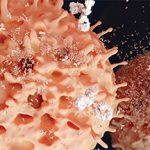The line of inquiry stems from the idea that “we have a therapeutic window of opportunity. Although we don’t know when it exactly starts and when it finishes, we have a feeling that when you treat patients that are diagnosed with rheumatoid arthritis, actually in the first few months after the disease, that we can be more effective in reaching remission and preventing erosions,” Dr. Gerlag said. An extension of that idea is that there is also a “preventive window of opportunity.”
One study at her center is looking at just how often people at high risk end up developing RA without treatment. So far, a cohort of 55 people, either with rheumatoid factor (IgM-RF) or who are ACPA-positive, has been followed for as long as 47 months. To date, 15 people, or 27%, have developed RA, and they have a follow-up range of 6 months to 27 months, with an average of 13 months.
Researchers also found that those with a BMI of 25 or higher, and who smoked at some point in their lives, had a hazard ratio of disease development of 7.5 compared to three other groups: those who have smoked and had a BMI of lower than 25, and those who have never smoked and had a BMI above or below 25.
In PRAIRI (Prevention of RA by Rituximab), researchers are planning to follow for four years patients with a high risk of developing RA. Their hope is that a 1,000-mg dose of the drug in the preclinical phase of the disease will help delay or prevent the development of RA.
So far, 95 patients have been enrolled, with 74 getting the medication. Sixteen, or 21%, have developed arthritis, with the average follow-up of six months until clinical arthritis developed.
“I think that prevention is better than cure and that the true window of opportunity is the preventive window of opportunity,” Dr. Gerlag said. “The question remains, of course, who do we treat, when do we treat them, and how do we treat them?”
Thomas Collins is a freelance medical writer based in Florida.


